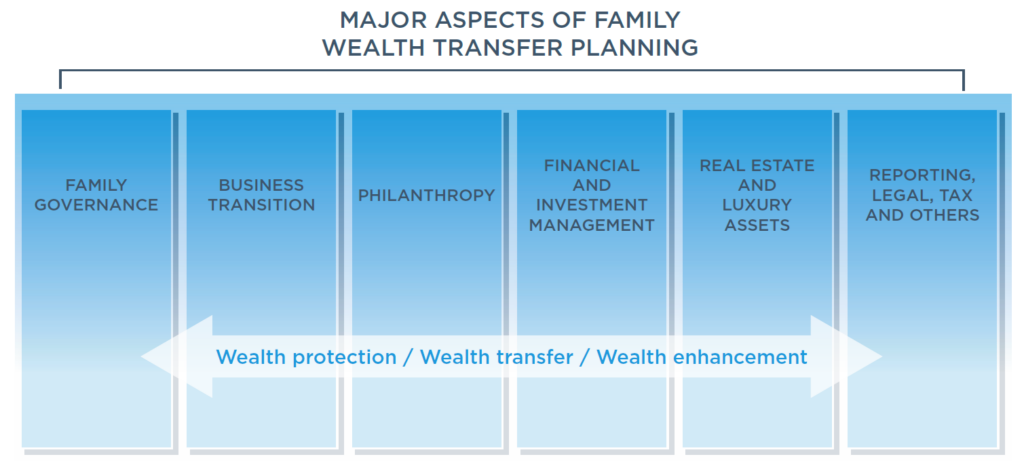In a world of rising complexity, globalized families and investments, surging wealth levels, rapid digitalization and a viral pandemic, the importance and challenges of wealth transfer cannot be overstated.
Wealthy families must overcome many hurdles to ensure their wealth is protected and continues to accumulate over the generations while still adhering to the family’s values and vision. These hurdles include the transition of ownership and management of one or more businesses, property and other assets, but also non-commercial concerns such as philanthropic foundations or art collections.
While wealth preservation is a relevant issue for many, this report focuses on the transfer of wealth over the next decade of an exclusive group of individuals — those with a net worth of more than $5m. This wealthy population totals almost 3 million individuals collectively holding assets worth more than $62trn worldwide.
We expect that around one-quarter of these individuals will seek to pass on their estates to the next generation between now and 2030, which will involve the transfer of a staggering level of wealth.
Learn more about this wealthy population and the implications of this generational wealth transfer by downloading the report today.

Key findings: Preservation and Succession: Family Wealth Transfer 2021
- Wealthy individuals and their families must navigate the important challenge of wealth transfer — that of wealth preservation and succession. In a world of rising complexity, such families have to overcome many hurdles to ensure their wealth is protected and continues to accumulate over the generations, while still adhering to the family’s values and vision.
- We expect $18.3trn of collective wealth will be transferred by those with $5m or more in net worth by 2030. This sum is greater than China’s annual GDP and more than seven times the market capitalization of US technology giant Microsoft. This wealth transfer will be carried out by almost 680,000 individuals across the world, averaging $27m per individual.
- UHNW individuals with a net worth of more than $100m will account for almost half of the $18.3trn to be transferred. The value of wealth being transferred will vary enormously across the different wealth tiers. Overall, the VHNW class will account for 87% of all individual wealth transfers by 2030, but only one-third ($6.2trn) of the total wealth being passed on.
- At $10.6trn, North America will account for almost 60% of the cumulative wealth transferred over the next decade. This is a testament to the scale of wealth in the US. Europe’s wealthy will pass on $3.6trn by 2030, accounting for 15% of all wealth transfers; some way ahead of third-ranked Asia, largely due to the latter’s wealthy class being younger than that of most other regions.
- The wealthy must confront a number of wealth transfer issues and trends in a fast-changing world. These include dealing with increasingly globalized families and investments, a younger generation that can often have a different outlook, the fallout from the Covid-19 pandemic as well as stricter reporting requirements and tax-planning practices.
- Those passing on wealth are largely male, self-made and interested in sports and philanthropy. Around 90% are men, most are between the ages of 70 and 80, and at least two-thirds of donors, if not more, have created their own fortunes without the help of inheritance. Philanthropy and sports are their two most popular interests by far.
Methodology:
In order to size wealth transfer and to profile those who will be passing on these fortunes, we use our Wealth Transfer Model and the Wealth-X Database.
Our Wealth Transfer Model sizes the number of wealthy individuals that will be passing on wealth and the amount of this wealth in the period to 2030 by wealth tier and by region. The model uses
a three-step process. First, the model uses Wealth-X’s Wealth and Investable Assets Model to size the general wealthy population by country and to estimate the total wealth held by individuals in each wealth tier. Second, we use the Wealth-X Database to incorporate age distribution by wealth. Third, we use secondary sources to integrate the life-expectancy distribution of wealthy individuals by country. We use life-expectancy data from 46 countries globally to estimate (with a 99% confidence level) the proportion of the population within each age bracket that will experience mortality within the next decade.
To gain further insight into the individuals passing on this wealth, we use the unique and proprietary Wealth-X Database, the world’s most extensive collection of curated research and intelligence on the wealthy. Our database provides insights into their financial profile,
career history, known associates, affiliations, family background, education, philanthropic endeavors, passions, hobbies, interests and much more. Our proprietary valuation model (as defined by net worth) assesses all asset holdings, including privately and publicly held businesses and investable assets. Wealth-X uses the primary business address as the determinant of a wealthy individual’s location. References to $ or dollars refer to US dollars.
Analysis of the data and additional insights were provided by the Wealth-X Analytics team. Leveraging the Wealth-X Database and its own data models, Wealth-X Analytics provides customizable data assets tailored to an organization’s needs.